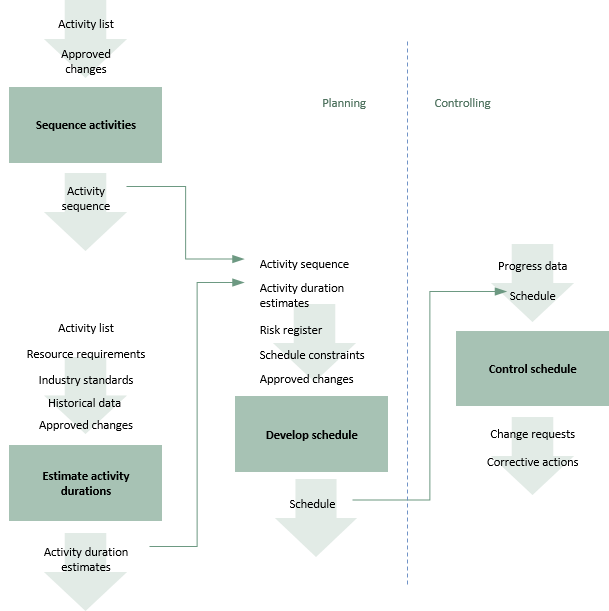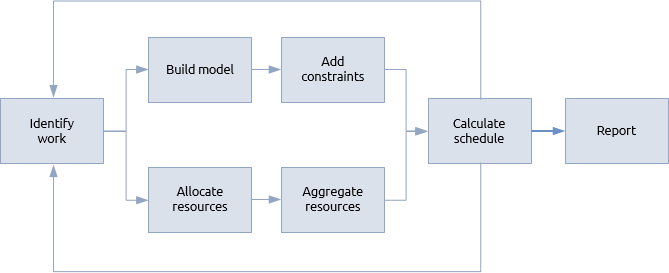The ISO21500 time subject area contains four processes.
ISO21500 process groups | |||||
|---|---|---|---|---|---|
| Initiating | Planning | Implementing | Controlling | Closing | |
Time | 4.3.21 Sequence activities 4.3.22 Estimate activity durations 4.3.23 Develop schedule | 4.3.24 Control schedule
| |||
In the diagram below, these processes are presented as a flow diagram using the inputs and outputs defined in ISO21500. There are three planning processes and one controlling process.
Click on the diagram for more detail on each process.

For clarity Praxis contains an overarching schedule management function which has two components: time scheduling and resource scheduling. The diagram below combines the time scheduling and resource scheduling procedures from Praxis to enable a better comparison with the ISO processes.

Praxis identifies the work as part of the schedule management procedure and then builds a model of the work, typically as a network diagram.
ISO21500 includes the definition of the activities required to produce the objectives of the project or programme within the scope area.
The define activities process produces an activity list which this process uses to create a model of the way wok will be performed. This typically takes the form of a precedence diagram.
This type of scheduling is normally limited to projects. Sequencing activities across multiple projects within a programme becomes complex. At programme level a simpler approach to the sequencing of projects and programme level activities should be taken.
4.3.22 Estimate activity durations
In Praxis, estimating is discussed as part of the planning function.
The purpose of estimating individual activities is to determine what resources will be needed and how long those resources will require to complete the activity. Not all activities in a network diagram will require resources but most do. This is an example of bottom-up estimating.
This process involves the use of the precedence network to calculate start and finish times for the activities.
The equivalent procedural step in Praxis is calculate schedule.
Different calculations can be performed that model the performance of the work in different ways. The simplest is critical path analysis (which doesn’t take account of resource limitations).
More sophisticated approaches include critical chain, resource limited scheduling, PERT analysis and Monte Carlo analysis. The latter two techniques involve a range of activity duration estimates rather than a single estimate.
The version of the schedule that is part of the initial project or programme plans is called the baseline schedule.
Schedule development will continue throughout the performance of the project. As changes are approved, new activities will be identified and the model updated. Corrective action will also lead to schedule updates.
Controlling the schedule involves monitoring progress data, updating the schedule and comparing this with the baseline schedule. If variances between the latest and baseline schedules are within agreed tolerances, then corrective action may be taken but there is no need to issue a change request.
The control function in Praxis addresses all forms of control, including schedule control.
If the baseline vs. actual variance is greater than the agreed tolerance, or predicted to exceed the tolerance, then a change request may be submitted to reset the baseline.
Understanding the true nature of progress is rarely a matter of simply looking at the start and finish dates of deliverables. Progress is a mixture if time variances, cost variances and resource variances. These are sometimes combined in techniques for tracking trends and forecasting future performance, such as earned value management.





